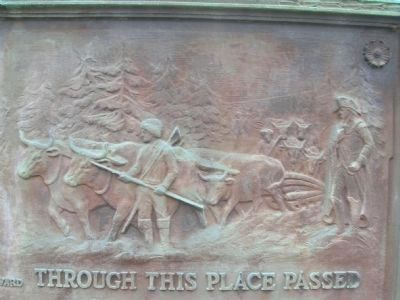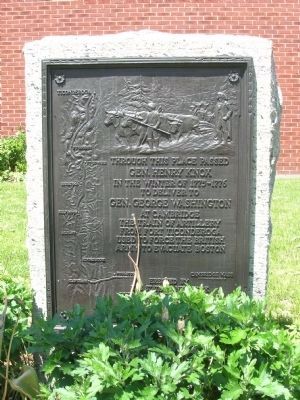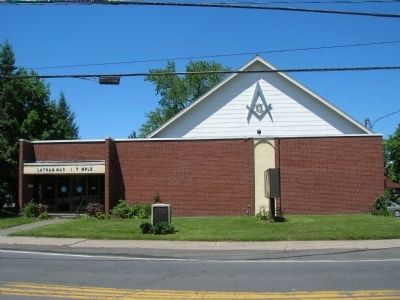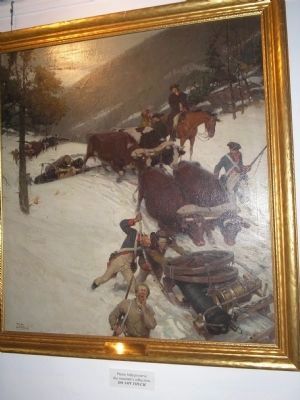Latham in Albany County, New York — The American Northeast (Mid-Atlantic)
Gen. Henry Knox Trail
Inscription.
Gen. Henry Knox
in the Winter of 1775 - 1776
to deliver to
Gen. George Washington
at Cambridge
the train of artillery
from Fort Ticonderoga
used to force the British
Army to evacuate Boston
Erected By
The State of New York
during the Sesquicentennial
of the American Revolution
Erected 1926 by State of New York. (Marker Number NY-20.)
Topics and series. This historical marker is listed in these topic lists: Forts and Castles • Military • Roads & Vehicles • War, US Revolutionary. In addition, it is included in the Former U.S. Presidents: #01 George Washington, and the General Henry Knox Trail series lists. A significant historical year for this entry is 1775.
Location. 42° 44.861′ N, 73° 45.535′ W. Marker is in Latham, New York, in Albany County. Marker is at the intersection of Old Loudon Road and Purtell Avenue, on the right when traveling south on Old Loudon Road. The Gen. Henry Knox Marker is on the front lawn of the Latham Masonic Temple at 206 Old Loudon Road, opposite (west of) Purtell Avenue in the hamlet of Newtonville. Touch for map. Marker is at or near this postal address: 206 Old Loudon Road, Latham NY 12110, United States of America. Touch for directions.
Other nearby markers. At least 8 other markers are within 3 miles of this marker, measured as the crow flies. Latham (approx. 0.2 miles away); Dalessondro Boulevard (approx. 2.6 miles away); Fox Preserve (approx. 2.6 miles away); James “Buttermilk” Lansing (approx. 2.6 miles away); Boght Church (approx. 2.7 miles away); Shaker Garage (1920) (approx. 2.7 miles away); The Boght (approx. 2.7 miles away); Ministry Shop (1825) (approx. 2.7 miles away).
More about this marker. The marker consists of a bronze plaque mounted on a large stone base. The plaque is attributed to sculptor Henry James Albright, 1887-1951.
A relief plaque on a stone marker commemorates General Henry Knox's delivery of artillery from Fort Ticonderoga to General George Washington at Cambridge, Massachusetts in the winter of 1775-1776. The image on the relief plaque depicts a young male figure driving a team of oxen. A uniformed male, probably General Knox, stands to the far right. The left side of the plaque contains a map that traces Knox's route from Fort Ticonderoga to Cambridge, also naming Ft George, Ft Edward, Saratoga, Halfmoon, Albany, Kinderhook, Claverach, and Noblestown.
Regarding Gen. Henry Knox Trail. The Henry Knox Cannon Trail denotes the path followed by Colonel Knox and his men from December
1775 to January 1776 to transport 59 captured weapon pieces from Fort Ticonderoga and Crown Point on Lake Champlain, New York to General George Washington at Dorchester Heights overlooking Boston, Massachusetts.
This pivotal event of the American Revolution resulted in the evacuation of British soldiers from Boston.
The Advisory Board on Battlefields and Historic Sites recommended that the state of New York purchase 30 granite markers in identical pattern, each with a bronze tablet featuring a map of the trail, an image in relief of cannon being dragged by ox sled through the snow, and the words:
"Through this place passed General Henry Knox in the winter of 1775 - 1776 to deliver to General George Washington at Cambridge the Train of Artillery from Fort Ticonderoga used to force the British army to evacuate Boston. Erected by the State of New York 1927."
In all, 30 of the bronze plaques are in New York State and 26 in Massachusetts. They represent the 56-day journey of American troops from Fort Ticonderoga to Boston.
The monuments were erected beginning in 1926, during the commemoration of the 150-year anniversary of the American Revolution, and completed in 1927. The trail is one of the earliest heritage paths created in the United States.
According to the Hudson River Valley Institute website, General Washington believed he could

Photographed By Howard C. Ohlhous, March 27, 2008
3. Gen. Henry Knox Trail Marker Detail
Detail of the Latham, New York (NY-20) Knox Canon Trail marker showing a young male figure driving a team of oxen. A uniformed male, probably General Knox, stands to the far right.
Recently a number of the Knox Canon Trail bronze plaques have received conservation work to restore the original sculptural detail that had been lost over time. Typically these plaques are restored using a technique developed in consultation with the National Park Service, which uses a system of air abrasive cleaning with a compound of pulverized walnut shells to attain the original finish and then they are sealed with a lacquer coating.
Recently a number of the Knox Canon Trail bronze plaques have received conservation work to restore the original sculptural detail that had been lost over time. Typically these plaques are restored using a technique developed in consultation with the National Park Service, which uses a system of air abrasive cleaning with a compound of pulverized walnut shells to attain the original finish and then they are sealed with a lacquer coating.
Henry Knox arrived at Fort Ticonderoga on the evening of December 5, 1775 accompanied by his 19-year-old brother William and a servant, Miller. Early the next day, assisted by the garrison of Fort Ticonderoga, he began to move the guns, including 43 heavy brass and iron cannons, 6 coehorns, 8 mortars and 2 howitzers.
In the second week of March, 1776, four months before the Declaration of Independence was signed, General Washington was ready to bombard the British in Boston from Dorchester Heights, using the array of heavy guns General Knox had laboriously dragged from Lake Champlain.
Lord William Howe recognized that only the evacuation of his army could save it, and on March 18 the victorious American army marched into the deserted city.
Related markers. Click here for a list of markers that are related to this marker. These markers follow the route used by Knox to transfer cannons from Fort Ticonderoga to Cambridge, Mass.
Also see . . .
1. Knox Trail. Hudson River Valley Institute
website entry (Submitted on July 20, 2021, by Larry Gertner of New York, New York.)
2. Henry Knox. Wikipedia biography (Submitted on July 20, 2021, by Larry Gertner of New York, New York.)
Additional keywords. George Washington, Ft George, Ft Edward, Saratoga, Halfmoon, Albany, Kinderhook, Claverach, Noblestown, Cambridge
Credits. This page was last revised on July 20, 2021. It was originally submitted on October 18, 2009, by Howard C. Ohlhous of Duanesburg, New York. This page has been viewed 2,753 times since then and 108 times this year. Photos: 1, 2. submitted on October 18, 2009, by Howard C. Ohlhous of Duanesburg, New York. 3. submitted on October 20, 2009, by Howard C. Ohlhous of Duanesburg, New York. 4. submitted on August 1, 2008, by Bill Coughlin of Woodland Park, New Jersey. 5. submitted on October 18, 2009, by Howard C. Ohlhous of Duanesburg, New York. • Kevin W. was the editor who published this page.



